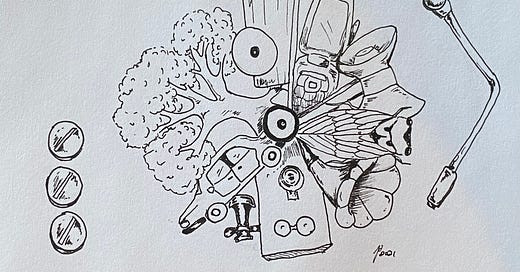Last night as I fell asleep, I heard the gentle music of the highway in the distance.
It got me to thinking: What music did our ancestors hear in the world around them? The music of nature, certainly, but what about the music of our own technologies and their impact on our ambient terrain? Go far enough back and it wouldn’t be the music of cars, but perhaps wagon wheels or horses, or something else entirely.
There are sounds that we now take for granted as a part of our world but that would confuse the hell out of a time-traveling interloper. The ding of a cell phone, the background hum of a washing machine, or (my least favorite) lawnmowers and leaf blowers. But what ambient sounds would have this effect on us? The creak of a street lamp opening as a lamplighter reaches a flame to it? Coal clattering in chutes or people chipping ice off blocks?
Did these sorts of ambient experiences impact our food and dining experiences? I don’t mean how and what we ate in a specific time period (e.g. more limited and seasonal food further back in history versus today’s supermarkets), but rather the actual connection between our eating experience and sound, or even sound and food itself.
Scientists have shown that what we listen to impacts our experience of a meal, and even the flavor of food itself.
One study found that disruptive sounds in restaurant environments: Either ambient noise or music, hampers our ability to taste food. Other studies have also examined how atmosphere (including sound) profoundly impacts restaurant dining experiences, and while I haven’t yet seen any on sound’s impact on our home environment, it seems safe to assume that one exists.
Another study found flavor differences between several cheeses that were aged while exposed to several different music genres (the cheese aged to A Tribe Called Quest came out on top). While the study notes the importance of bacteria and environmental conditions to the final flavor of the cheese, it also posits that soundwaves themselves might have an impact.
If we want to really jump down some rabbit holes, we can get into the problematic and tricky terrain of “authenticity” in historic cuisines: If sound has an impact on the structure of something like cheese (the results on that are forthcoming), can we say that a historic recreation is “correct” unless it’s exposed to a similar ambient environment?
N.B. I have some strong opinions about authenticity as it relates to food and about the frustration and futility, and plain old missing the point, of striving for authenticity in cooking dishes from the past. But since this is all thought experiment territory, we’ll save those rants for another day.
This is all perhaps a flight of fancy, but it is a fun one nonetheless, and it piques a few of my interests as well as the way I experience the world with synesthesia (though mine isn’t auditory-based).
I tend to enjoy quieter eating environments, so what environments in the past would provide the most amenable atmosphere to enjoy my food (bear in mind that the past was often not a quiet place: There was still plenty of clattering, banging, and carrying on)?
If someone is playing a game on a phone or tablet with sound on, it ruins the eating experience for me: Is there a correlate in the past, something that would distract me irreperably from the food in front of me?
I don’t usually open comments but I have here because I want to hear what you think. How would a meal eaten to the music of past worlds taste different to you?
P.S. This was largely written on my phone while falling asleep: Proof that food is never far from my mind.






The sounds of your “next meal” close by - chickens, goats, pigs. People were up-close-and-personal with their food back then. They may have even been housemates!
I absolutely love your post. For me, tiny birds with their tiny chirping song and sunlight. At night, the twinkle of stars or Christmas lights that are still up way after December accompanied by a distant wind chime.